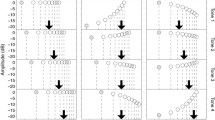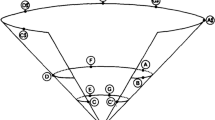Abstract
In spatial-sequence synesthesia, ordinal sequences are visualized in explicit spatial locations. We examined a recently documented subtype in which musical notes are represented in spatial configurations, to verify consistency and automaticity of musical pitch-space (M-S) synesthesia. An M-S synesthete performed a mapping pre-task (Exp. 1) used to indicate the locations of 7 auditory or visually presented notes, in 2 sessions a month apart. Results revealed strong correlations between sessions, suggesting the synesthete’s musical forms were consistent over time. Experiment 2 assessed automaticity of M-S synesthesia. The same synesthete and matched controls preformed a spatial Stroop-like task. Participants were presented with an auditory or visual musical note and then had to reach for an asterisk (target) with a mouse cursor. The target appeared in a compatible or incompatible location (according to the synesthete’s spatial representation). A compatibility effect was found for the synesthete but not for controls. The synesthete was significantly faster when the target appeared in compatible locations than in incompatible ones. Our findings show that for synesthetes, auditory and visually presented notes automatically trigger attention to specific spatial locations according to their specific M-S associations.





Similar content being viewed by others
References
Akiva-Kabiri L, Gertner L, Henik A (2012) Space is alive with the sound of music: the case of musical tone-space synaesthesia. In: Seifert U, Wewers J (eds) SysMus11 fourth international conference of students of systematic musicology, epOs music. http://www.epos.uni-osnabrueck.de/music/start_e.html
Friesen CK, Kingstone A (1998) The eyes have it!: reflexive orienting is triggered by nonpredictive gaze. Psychon Bull Rev 5:490–495
Hochel M, Milan EG (2008) Synaesthesia: the existing state of affairs. Cogn Neuropsychol 25:93–117
Hubbard EM, Ramachandran VS (2005) Neurocognitive mechanisms of synesthesia. Neuron 48:509–520
Jarick M, Dixon MJ, Stewart MT, Maxwell EC, Smilek D (2009) A different outlook on time: visual and auditory month names elicit different mental vantage points for a time-space synesthete. Cortex 45:1217–1228
Ramachandran VS, Hubbard EM (2001) Synaesthesia: a window into perception, thought and language. J Conscious Stud 8:3–34
Rich A, Mattingley JB (2002) Anomalous perception in synaesthesia: a cognitive neuroscience perspective. Nat Rev Neurosci 3:43–52
Rusconi E, Kwan B, Giordano BL, Umilta C, Butterworth B (2006) Spatial representation of pitch height: the SMARC effect. Cognition 99:113–129
Teuscher U, Brang D, Ramachandran VS, Coulson S (2010) Spatial cueing in time–space synesthetes: an event-related brain potential study. Brain Cogn 74:35–46
Tzelgov J (1997) Specifying the relations between automaticity and consciousness: a theoretical note. Conscious Cogn 6:441–451
Zatorre RJ (2003) Absolute pitch: a model for understanding the influence of genes and development on neural and cognitive functions. Nat Neurosci 6:692–695
Conflict of interest
This supplement was not sponsored by outside commercial interests. It was funded entirely by ECONA, Via dei Marsi, 78, 00185 Roma, Italy.
Author information
Authors and Affiliations
Corresponding author
Rights and permissions
About this article
Cite this article
Linkovski, O., Akiva-Kabiri, L., Gertner, L. et al. Is it for real? Evaluating authenticity of musical pitch-space synesthesia. Cogn Process 13 (Suppl 1), 247–251 (2012). https://doi.org/10.1007/s10339-012-0498-0
Published:
Issue Date:
DOI: https://doi.org/10.1007/s10339-012-0498-0




